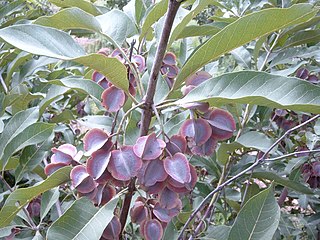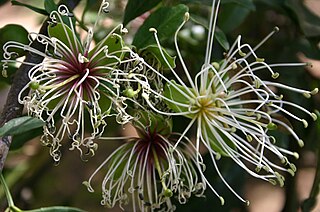
Combretum, the bushwillows or combretums, make up the type genus of the family Combretaceae. The genus comprises about 272 species of trees and shrubs, most of which are native to tropical and southern Africa, about 5 to Madagascar, but there are others that are native to tropical Asia, New Guinea and the Bismarck Archipelago, Australia, and tropical America. Though somewhat reminiscent of willows (Salix) in their habitus, they are not particularly close relatives of these.

Gladiolus is a genus of perennial cormous flowering plants in the iris family (Iridaceae).

Ocimum is a genus of aromatic annual and perennial herbs and shrubs in the family Lamiaceae, native to the tropical and warm temperate regions of all 6 inhabited continents, with the greatest number of species in Africa. Its best known species are the cooking herb basil, O. basilicum, and the medicinal herb tulsi, O. tenuiflorum.

Ochna is a genus comprising 79 species of evergreen trees, shrubs and shrublets belonging to the flowering plant family Ochnaceae. These species are native to tropical woodlands of Africa, Madagascar, the Mascarenes and Asia. Species of this genus are usually called ochnas, bird's-eye bushes or Mickey-mouse plants, a name derived from the shape of the drupelet fruit. The name of this genus comes from the Greek word ὄχνη (ókhnē), used by Theocritus and meaning "wild pear", as the leaves are similar in appearance. Some species, including Ochna integerrima and O. serrulata, are cultivated as decorative plants.

Cleome is a genus of flowering plants in the family Cleomaceae, commonly known as spider flowers, spider plants, spider weeds, or bee plants. Previously, it had been placed in the family Capparaceae, until DNA studies found the Cleomaceae genera to be more closely related to the Brassicaceae than the Capparaceae. Cleome and clammyweed can sometimes be confused.

Cryptosepalum is a genus of flowering plants in the family Fabaceae. There are 12 species, mostly trees. They are native to sub-Saharan Africa, ranging from Guinea to Tanzania, Mozambique, and Angola.

Kotschya is a genus of legumes in the family Fabaceae. It includes 30 species native to sub-Saharan Africa. The genus was recently assigned to the informal monophyletic Dalbergia clade of the Dalbergieae. It contains the following species:

Cadaba is a genus of shrubs in family Capparaceae, with about 30 species. These have simple, alternately set leaves. The zygomorphic flowers, are solitary or stand in small clusters at the end of short side branches. These flowers consist of four sepals, none or four petals with a narrow claw at base and a wider plate at the top, a tube-shaped nectar producing appendix, four or five stamens that are merged for about half their length into a so-called androgynophore, and a gynophore on top of which will develop a cylindrical capsule with one or two cavities that contain many small kindney-shaped seeds, and opens with two valves. The genus name Cadaba is derived from the Arab word "kadhab", a local name for Cadaba rotundifolia. Some species are classified as famine food in southern Ethiopia.

Campylospermum is a genus of flowering plants in the family Ochnaceae. It includes 55 species native to tropical Africa, India, Indochina, Hainan, and western Malesia.

Capparis is a genus of flowering plants in the family Capparaceae. It includes 142 species of shrubs or lianas which are collectively known as caper shrubs or caperbushes. Capparis species occur over a wide range of habitat in the subtropical and tropical regions of Africa, Eurasia, Australasia, and the Pacific.

Faurea is a genus containing 16 species of flowering plants in the protea family which occur in the summer rainfall area of southern Africa, extending to tropical Africa and Madagascar. The name honours South African soldier and botanist William Caldwell Faure (1822-1844) who was killed on active service in India.

Maerua is a genus of flowering plants in the family Capparaceae. It includes 70 species of shrubs and small trees with its centre of diversity in Africa, though some species extend their range as far north as the Levant, and as far east as the Indian subcontinent and mainland Southeast Asia.

Humularia is a genus of flowering plants in the legume family, Fabaceae. It includes 34 species native to sub-Saharan Africa, ranging from South Sudan to Cameroon, Angola, Malawi, and Tanzania. Species include herbs with woody bases and occasionally small shrubs. Typical habitats include seasonally-dry tropical woodland, wooded grassland, scrub, and grassland, often along stream banks, swamp margins, floodplains, and sandy areas, and sometimes in montane areas. The genus belongs to the subfamily Faboideae, and was recently assigned to the informal monophyletic Dalbergia clade of the Dalbergieae.
Cryptosepalum exfoliatum is a species of tree native to tropical Africa. It ranges from the Republic of the Congo and Democratic Republic of the Congo to Tanzania, Zambia, Malawi, and Angola. It is the dominant tree species in the Zambezian Cryptosepalum dry forests ecoregion of Zambia and Angola, where it is known locally as "mavunda". Cryptosepalum exfoliatum forests form habitat for the butterfly Mylothris mavunda.

Haumaniastrum is a genus of flowering plants in the mint family, Lamiaceae, first described in 1959. The species are native to Africa.

Deinbollia is a genus of flowering plants belonging to the family Sapindaceae.

Buchnera is a genus of flowering plants belonging to the family Orobanchaceae. Its native range is Northern and Tropical America, Tropical and Southern Africa, Madagascar, Arabian Peninsula Tropical Asia, Australia.
Helen Holme Simmons FRS FLS, commonly known as Nellie Bancroft, was a British botanist and scientific illustrator famous for her work on plant systematics and the anatomy of both living and fossil plants. Bancroft was while working for the Imperial Forestry Institute in France in 1940 captured by the Germans and spent four years in internment before being released and returning home in 1944.
















